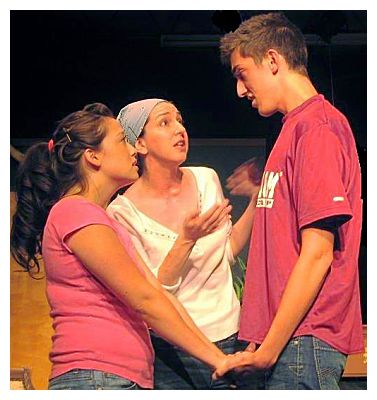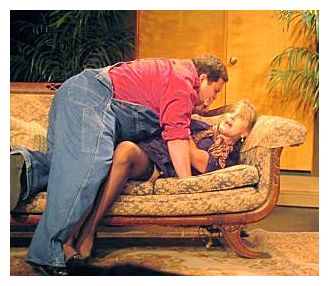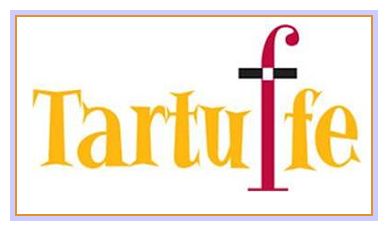Review: Tartuffe by The City Theatre Company
by Michael Meigs
Molière was appalled and distressed when he learned that although Louis XIV had enjoyed the court performance of Tartuffe on May 12, 1664 the "Sun King" had listened to pious advisers and had forbidden any further presentations of the play.
This great comic tale of religious hypocrisy was in trouble from the start. The dramatist had produced a farce in elegant verse featuring a "holy man" intent on seduction, theft and exploitation, an adroit manipulator of religious concepts and of religious language. The court advisers were probably scandalized at the playwright's witty undermining of religiosity and some of them may have felt directly targeted.
Molière's eloquent protests went unheeded and the revised version he presented publicly three years later was immediately shut down. Not until 1669, after a delay of five years, was Tartuffe performed, apparently with the King's permission. It became the most successful and most profitable of Molière's plays.
Charles P. Stites serves as something of a Molière for the City Theatre's production of Tartuffe. He drafted this text, directed it and stars as Tartuffe.
And what better setting for religious hypocrisy (via tele-evangelism) than modern Central Texas?
Stites explained to Sean Fuentes at AustinTheatre Review how he'd revised the text:
"I got three different English translations of Tartuffe and a few legal pads, sat down at my dining table, and went through the three scripts line-by-line, comparing the work of the three authors, and then deciding what a contemporary man or woman might say instead, editing as I went along."
His text for Tartuffe gives the characters prose written in punchy colloquial Modern Texan, a subtly showy transformation of Molière's language that avoids starchy formalisms sometimes used by translators, especially by those who are working in verse. There's a touch too much scatology for my taste, but I won't argue with a native.
 Language is not all, however. Molière's play is highly structured, and in this two-act formulation of the original five acts, we witness a relatively tedious set-up.
Language is not all, however. Molière's play is highly structured, and in this two-act formulation of the original five acts, we witness a relatively tedious set-up.
It starts with a burst. Grandma Pernelle, matriarch of the clan, is berating each family member and their serving girl Dorine about their dislike for the newly resident holy man, Tartuffe. Kim Rubin as Mme Pernelle gets off some zingers before storming off.
 Head of the household Orgon (Wray Crawford) arrives shortly afterward and has no patience for the lengthy admonitions of his brother-in-law Cleante (D. Heath Thompson). We see Orgon's obsession with the good Tartuffe and learn quickly that Orgon intends to oblige his daughter Mariane to break an engagement in order to marry the holy man.
Head of the household Orgon (Wray Crawford) arrives shortly afterward and has no patience for the lengthy admonitions of his brother-in-law Cleante (D. Heath Thompson). We see Orgon's obsession with the good Tartuffe and learn quickly that Orgon intends to oblige his daughter Mariane to break an engagement in order to marry the holy man.
Orgon tells this to Mariane in a lengthy confrontational scene with comic interruptions by serving woman Dorine (the attractively whimsical Aleta Garcia). After Dad delivers his ultimatum, canny Dorine advises Mariane (Fiona Rene) and her fiancé Valere (Austin Rausch), who quarrel and then make up. Dorine then calms down Mariane's brother, the hot-headed Damis (Errich Peterson).
Curtain.
Just before the lights, though, we get a glimpse of the villain himself, Tartuffe. It's a Mephistophelian moment, designed to keep us on board with the intrigue.
After the intermission, with Tartuffe in the action, Tartuffe takes off.

 Stites as Tartuffe is a grinning chunky guy with a red shirt, broad overalls and missing front teeth. He has a strong, scary stage presence and makes us appreciate the hypocrite's charisma, guile, avarice and lust, all simultaneously. His timing and mastery of the text bring it alive, initially in his attempted seduction of Orgon's wife Elmire (Sarah Seaton) and then in his interplay with Crawford as Orgon.
Stites as Tartuffe is a grinning chunky guy with a red shirt, broad overalls and missing front teeth. He has a strong, scary stage presence and makes us appreciate the hypocrite's charisma, guile, avarice and lust, all simultaneously. His timing and mastery of the text bring it alive, initially in his attempted seduction of Orgon's wife Elmire (Sarah Seaton) and then in his interplay with Crawford as Orgon.
The family works to convince Orgon that his saint is in fact made of plaster or even of some much baser material. It's heavy going for the anti-Tartuffians. There's a bond between Tartuffe and Orgon, and Stites and Crawford are both bigger than life. When playing against one another, they supercharge the production.
 The obligatory titillation and revelation come in a trap laid by Elmire, who endures Tartuffe's advances in order to convince her husband, hiding nearby, of the man's perfidy. Once Orgon finally understands, his game has already been lost, for Tartuffe has gained legal possession of all his goods and estate. As the civil but decisive bailiff (MacArthur Moore) is closing in, Molière produces a deus-ex-machina in the guise of orders from the benevolent Sun King, ever vigilant for his subjects (in this version, in fact, an Obama-ex-machina).
The obligatory titillation and revelation come in a trap laid by Elmire, who endures Tartuffe's advances in order to convince her husband, hiding nearby, of the man's perfidy. Once Orgon finally understands, his game has already been lost, for Tartuffe has gained legal possession of all his goods and estate. As the civil but decisive bailiff (MacArthur Moore) is closing in, Molière produces a deus-ex-machina in the guise of orders from the benevolent Sun King, ever vigilant for his subjects (in this version, in fact, an Obama-ex-machina).
Why the slow start, overcome so smartly by the successive revelations of the second half?
In my view, it's a question of language, prose vs. verse, and different acting styles. Molière wrote in rhyming alexandrine couplets, using a twelve-syllable line with a mid-line caesura. This French verse form ticks like a metronome. Part of the delight of reading or hearing Molière is the statement-and-response game of the verse. His genius keeps the bouncing ball in motion and cleverly caps the rhyming couplets. The listener or reader follows both the argument and the expression of it; action progresses through the play of language.
A prose translation of Molière into English risks losing the vivacity of this language. Stite's Modern Texas version drawn from three English translations is at two or three removes from the original. It retains Molière's arguments in their full length but with diminished grace, somewhat superfluous to the action. Brother-in-law Cleante, for example, becomes tediously sententious, and the lovers' quarrel in Act II, scene 4 becomes adolescent sulking and shouting.
A prose version of Tartuffe, in order to sparkle, requires a lively staging, strong actors, a strong concept -- and maybe even some judicious cutting, especially in the first half. City Theatre has most of these, and if you can hold on until Tartuffe strides onstage at the opening of Act II, you'll have a fine time seeing the hypocrite get his comeuppance.
Review by Ryan E. Johnson at Examiner.com, July 29
Review by Hannah Kenah for the Austin Chronicle, July 30
Click to view program from Tartuffe, City Theatre
Hits as of 2015 03 01: 7639
Tartuffe
by Molière
City Theatre Company
